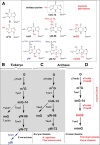Biosynthesis of wyosine derivatives in tRNA(Phe) of Archaea: role of a remarkable bifunctional tRNA(Phe):m1G/imG2 methyltransferase
- PMID: 24837075
- PMCID: PMC4024628
- DOI: 10.1261/rna.043315.113
Biosynthesis of wyosine derivatives in tRNA(Phe) of Archaea: role of a remarkable bifunctional tRNA(Phe):m1G/imG2 methyltransferase
Abstract
The presence of tricyclic wyosine derivatives 3'-adjacent to anticodon is a hallmark of tRNA(Phe) in eukaryotes and archaea. In yeast, formation of wybutosine (yW) results from five enzymes acting in a strict sequential order. In archaea, the intermediate compound imG-14 (4-demethylwyosine) is a target of three different enzymes, leading to the formation of distinct wyosine derivatives (yW-86, imG, and imG2). We focus here on a peculiar methyltransferase (aTrm5a) that catalyzes two distinct reactions: N(1)-methylation of guanosine and C(7)-methylation of imG-14, whose function is to allow the production of isowyosine (imG2), an intermediate of the 7-methylwyosine (mimG) biosynthetic pathway. Based on the formation of mesomeric forms of imG-14, a rationale for such dual enzymatic activities is proposed. This bifunctional tRNA:m(1)G/imG2 methyltransferase, acting on two chemically distinct guanosine derivatives located at the same position of tRNA(Phe), is unique to certain archaea and has no homologs in eukaryotes. This enzyme here referred to as Taw22, probably played an important role in the emergence of the multistep biosynthetic pathway of wyosine derivatives in archaea and eukaryotes.
Keywords: COG2520; archaea; methyltransferase; modification; transfer RNA.
© 2014 Urbonavičius et al.; Published by Cold Spring Harbor Laboratory Press for the RNA Society.
Figures


Similar articles
-
Evolution of tRNAPhe:imG2 methyltransferases involved in the biosynthesis of wyosine derivatives in Archaea.RNA. 2016 Dec;22(12):1871-1883. doi: 10.1261/rna.057059.116. Epub 2016 Oct 20. RNA. 2016. PMID: 27852927 Free PMC article.
-
Biosynthesis of wyosine derivatives in tRNA: an ancient and highly diverse pathway in Archaea.Mol Biol Evol. 2010 Sep;27(9):2062-77. doi: 10.1093/molbev/msq096. Epub 2010 Apr 9. Mol Biol Evol. 2010. PMID: 20382657 Free PMC article.
-
Biochemical Pathways Leading to the Formation of Wyosine Derivatives in tRNA of Archaea.Biomolecules. 2020 Dec 2;10(12):1627. doi: 10.3390/biom10121627. Biomolecules. 2020. PMID: 33276555 Free PMC article. Review.
-
Conformational preferences and structural analysis of hypermodified nucleoside, peroxywybutosine (o2yW) found at 37th position in anticodon loop of tRNAPhe and its role in modulating UUC codon-anticodon interactions.Gene. 2018 Jan 30;641:310-325. doi: 10.1016/j.gene.2017.10.072. Epub 2017 Oct 26. Gene. 2018. PMID: 29107006
-
tRNA-m1G methyltransferase interactions: touching bases with structure.Biochimie. 1995;77(1-2):62-5. doi: 10.1016/0300-9084(96)88105-3. Biochimie. 1995. PMID: 7599277 Review.
Cited by
-
Diversity in mechanism and function of tRNA methyltransferases.RNA Biol. 2015;12(4):398-411. doi: 10.1080/15476286.2015.1008358. RNA Biol. 2015. PMID: 25626150 Free PMC article. Review.
-
Methionine Adenosyltransferase Engineering to Enable Bioorthogonal Platforms for AdoMet-Utilizing Enzymes.ACS Chem Biol. 2020 Mar 20;15(3):695-705. doi: 10.1021/acschembio.9b00943. Epub 2020 Mar 3. ACS Chem Biol. 2020. PMID: 32091873 Free PMC article.
-
Naturally occurring modified ribonucleosides.Wiley Interdiscip Rev RNA. 2020 Sep;11(5):e1595. doi: 10.1002/wrna.1595. Epub 2020 Apr 16. Wiley Interdiscip Rev RNA. 2020. PMID: 32301288 Free PMC article. Review.
-
Distinct Modified Nucleosides in tRNATrp from the Hyperthermophilic Archaeon Thermococcus kodakarensis and Requirement of tRNA m2G10/m22G10 Methyltransferase (Archaeal Trm11) for Survival at High Temperatures.J Bacteriol. 2019 Oct 4;201(21):e00448-19. doi: 10.1128/JB.00448-19. Print 2019 Nov 1. J Bacteriol. 2019. PMID: 31405913 Free PMC article.
-
Transfer RNA methyltransferases with a SpoU-TrmD (SPOUT) fold and their modified nucleosides in tRNA.Biomolecules. 2017 Feb 28;7(1):23. doi: 10.3390/biom7010023. Biomolecules. 2017. PMID: 28264529 Free PMC article. Review.
References
-
- Bujnicki JM 2000. Phylogenomic analysis of 16S rRNA:(guanine-N2) methyltransferases suggests new family members and reveals highly conserved motifs and a domain structure similar to other nucleic acid amino-methyltransferases. FASEB J 14: 2365–2368 - PubMed
-
- Cannon LM, Butler FN, Wan W, Zhou ZS 2002. A stereospecific colorimetric assay for (S,S)-adenosylmethionine quantification based on thiopurine methyltransferase-catalyzed thiol methylation. Anal Biochem 308: 358–363 - PubMed
Publication types
MeSH terms
Substances
LinkOut - more resources
Full Text Sources
Other Literature Sources
